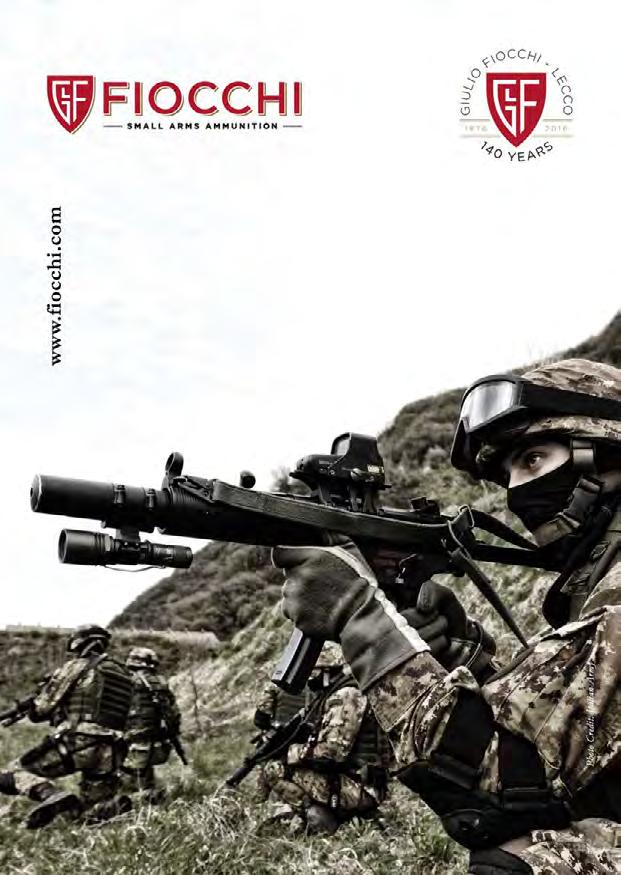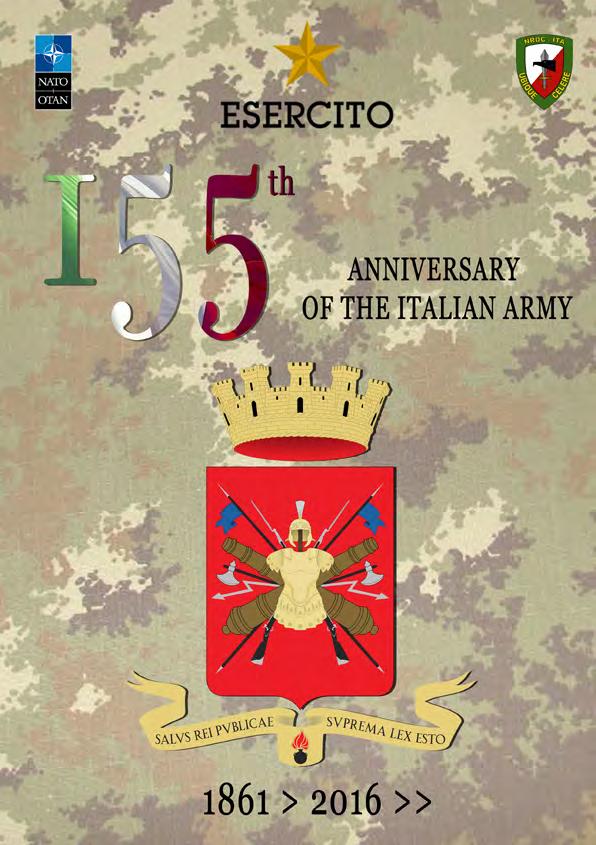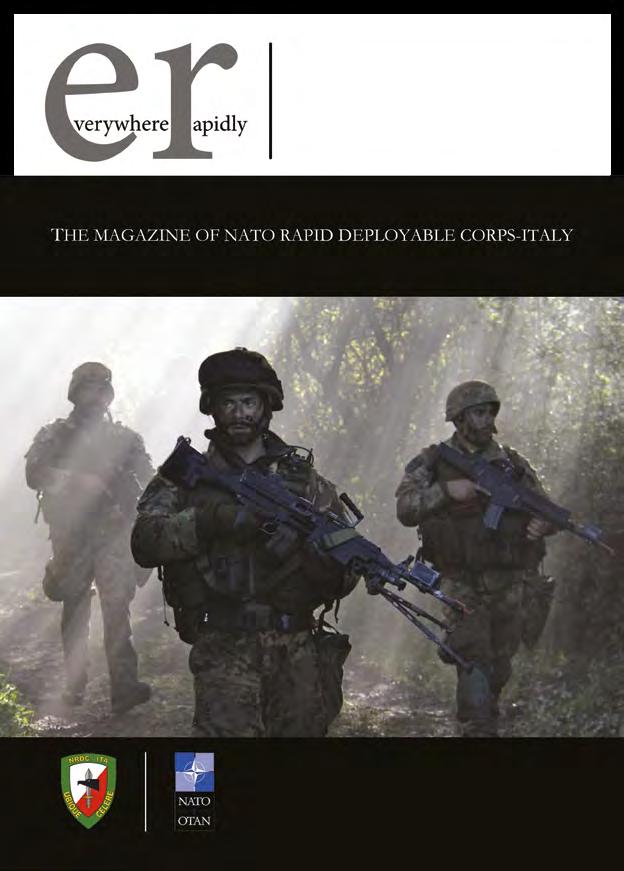





Dear Reader,
Welcome back after four challenging months! It is with pleasure that I present to you this 2016 “Everywhere Rapidly” second issue. The first year as a stand-by Joint Task Force (JTF) has just finished for NRDC-ITA, and the Headquarters has already started to face a second year as confirmed. The results of the activities conducted during this period have been helpful to understand the capabilities of the Headquarters and its staff in terms of professional preparation, readiness and deployability. Many tests have been done, new activities have been hosted, above all exercise “Sea Eagle (Land) 2016”. The exercise has been structured to test NRDC-ITA’s deployable Command and Control (C2) capability. Following the principles of the “Command Post Concept” such as the deployment of the “Forward Coordinating Element” (FCE) and the “Initial Command Element” (ICE) capability blocks, NRDC-ITA staff have been able to test and validate the concept, identifying any possible critical area for further refinement.

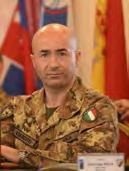
ce pillar within the NATO community. The aim of the event was to enhance the non-lethal and communication capabilities perspective in operations and to share experiences and lessons learned after the transformation and validation process to JTF, both with the Military and the Academic world. It goes without saying that the contents of this issue are a partial representation of the amount of demanding activities held. Following this path, this HQ will also continue to keep its level of readiness high during the next stand-by year, through dedicated training activities, sharing the results with other Commands.
Lieutenant General ITA (A) Riccardo Marchiò
Editor in Chief: Col. ITA (A) Gianluigi ARCA
Editors : Lt. Col. ITA (A) Fabio DE MASSARI, Maj ITA (A) Vincenzo SCHETTINI
Assistant Editor: Cpl. ITA (A) Chiara MONTI ......................
Assistant in Imagery and Post Production: WO ITA (A) Francesco CIVITELLI
Photographers: Cpl. ITA (A) Raffaele SANSEVERINO, Cpl. ITA (A) Marina DORE, Cpl. ITA (A) Mattia RUSSO
The everywhere rapidly is the autorized official pubblication of NATO Rapid Deployable Corps, Italy. All editorial content of the everywhere rapidly is prepared , edited and approved by the NRDC -ITA Commander, at “ Ugo Mara” barracks, via per Busto Arsizio, 20 - 21058 Solbiate Olona , Varese, Italy.
Another successful event has also been the first NRDC-ITA International Influence Conference, held in April, the first high profile seminar on the Influen-
Before I leave you to read our magazine, let me express special thanks to those children who dedicated their little spare time to share on the NRDC-ITA Facebook platform their wonderful pictures, depicting their father or mother at work in NRDC-ITA. Their masterpieces are well presented on the facing page: the most voted image has been Samuele’s art work, the central and bigger one, but we chose to give to every little artist the opportunity to appear with his interesting and clever contribution in the NATO community. Thank you for your kind attention and enjoy your reading!
The Everywhere Rapidly is published by the Public Affairs Office. Contents of the Everywhere Rapidly are not necessarily the official views of, or endorsed by the North Atlantic Treaty Organization and the Nations thereby rapresented.
All intellectual property rights, including copyright in the content displayed on the everywhere rapidly, belong to their respective owners. All material and information , including comments, are governed by the doctrine of fair use. The Publication and the content may only be used for lawful purposes. For this purpose alone one may print out, reproduce, or photocopy as needed.
The editor reserves the right to edit all submissions for style, brevity and clarity.
Printed by SpinnakerNr 22 ISSUE 01/2016
Errata Corrige
-Pag. 16 : Brig. Gen. GRC (A) Christos Drivas is the JLSG Commander
-Pag. 33: The correct abbreviation of Slovenia is SLV



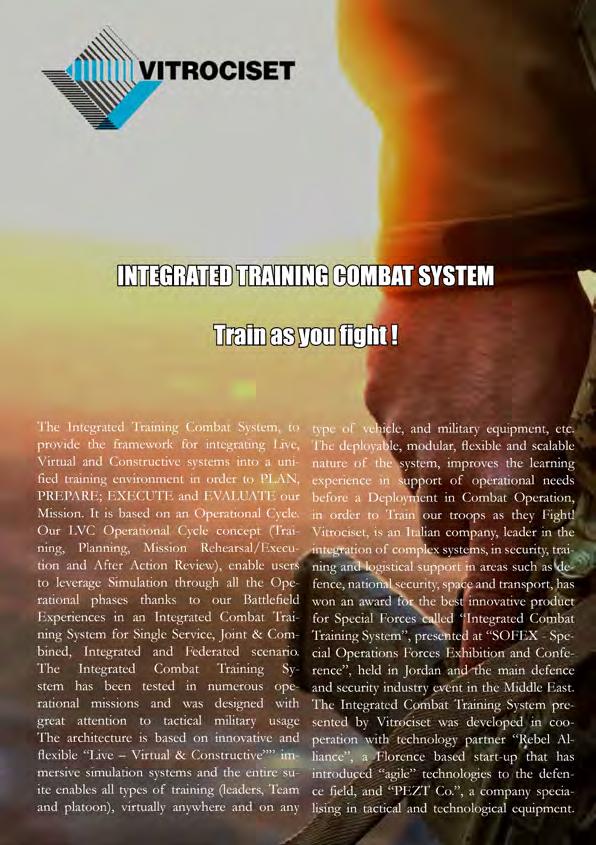

The recent past has been demanding in terms of the variety of threats to the international security environment and is posing some challenges to the transformation and adaptation process of the Alliance. As a flexible tool to respond to common security requirements, the NATO Rapid Deployable Corps – Italy is also continuously adapting and revising its structure and professional standards, to fit with its role as a rapidly deployable joint and combined Force.
To do so, the “Ugo Mara” barracks HQ has just finished an intense period of training to maintain its capability as a Joint Task Force, achieved last year in Stavanger (Norway) at the NATO Joint Training Centre. In order to maintain this capability for another stand-by year, new exercises, seminars and training events have been scheduled and are under staff planning revision. The results of some of the activities which have already taken place are examined in this issue of the magazine.
NRDC-ITA also represents a point of reference and added value for the region, not only in terms of ensuring military capability, but also as an International Institution commonly recognized as part of one of the most relevant and dynamic socio-economic are-

as in Europe, as northern Italy is. This edition of “Everywhere Rapidly” has been issued together with a special insert on the socio-economic impact of the HQ on the area: it demonstrates the integration of the NRDC-ITA and its serving personnel with the different strands of society within Lombardy, showing how the NRDC-ITA adds value.
NRDC-ITA personnel have always viewed their mission as an opportunity to promote a renewed Alliance, still true to its principles but, at the same time, under continuous transformation in order to be capable of responding promptly to new security threats.
I firmly believe that this new opportunity to share our ideas within the Alliance and the troop-contributing nations will give rise to fruitful exchanges that will further our professional preparation. This will allow all of us to ensure that the NATO Rapid Deployable Corps – Italy, living up to its motto “Ubique Celere”, “Everywhere Rapidly”, will always be able to pave the way for a better and safer world.



Major General Edward Smyth-Osbourne arrived in the NRDC-ITA on 4 July to take up the reins as the new Deputy Commander, following the departure of Lieutenant General Sir George Norton in early May. General Smyth-Osbourne’s extensive operational experience, over the course of more than 30 years, will be of great benefit for a headquarters that is currently on standby for the VJTF and preparing for a LCC role.
Born and brought up in the West Country and educated at West Downs, Eton and St Andrews, he enlisted in the Army and joined The Life Guards in West Germany in October 1983. His time at Regimental Duty saw him in various roles ranging from Troop Leader to Commanding Officer, in the United Kingdom, Europe, Central America, the Balkans, the Middle East and Asia. His time as Commanding Officer of the Household Cavalry Regiment included a tour of Afghanistan in 2007. It was also during his time in command that Princes William and Harry joined the Regiment as junior officers.His numerous appointments as a staff officer include, among others, chief of staff of a regional brigade, the chief of training at the British Army Training Unit Suffield, Western Canada, Military Assistant to the Commander in Chief, and a staff officer in the Ministry of Defence.
Additional commands include the Intelligence, Surveillance and Reconnaissance Task Force in Kosovo, and the 38th (Irish) Brigade in Ulster (Northern Ireland) in 2009. In July 2013 he was appointed General Officer Commanding Headquarters London District. This encompassed command of all troops in the London area as well as responsibility for ceremonial matters involving the Royal Family, such as the Queen’s Birthday Parade. It is from there that he has now joined the NRDC-ITA.
His military education includes the Staff College at Camberley and the Higher Command and Staff Course at the UK Defence Academy in Shrivenham.

He has arrived in Italy with his wife and two children. Given his wide variety of interests, such as shooting, fishing, skiing and sailing, and his professional experience, it is hoped that the General’s new environment will prove satisfying at all levels.

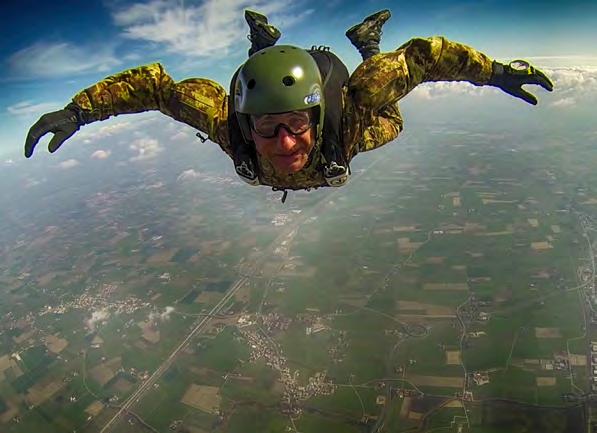
Officers, Non-Commissioned Officers, Servicemen and Servicewomen,
First of all allow me to say how honoured I am to serve as your Command Sergeant Major.
Last year, when Lt. Gen. Riccardo Marchiò asked me to be part of this great team as Command Sergeant Major at NRDC-ITA HQ, I really could not find the words! Given the importance of the position, honestly speaking, I was a little bit apprehensive - I had never been selected for such an important job before. At my previous units, this job is normally performed by the eldest Non Commissioned Officer.
I have always been employed for my expertise, and, being a Ranger, you may well understand that what I have done until now is quite different from what I have been called to do at this prestigious Headquarters. For this reason I took some time to decide, but being here today means that I am absolutely ready to face this new


and exciting challenge, and to live up to it. My decision is supported by some important reasons, which absolutely reflect the values and principles I believe in. People who made the choice to raise their right hand and enlist in the Armed Forces all play a vital role when it comes to stand to the rules as well as ensuring the accomplishment of the mission.
Even though I made that choice some years ago, I know I still have a great deal of passion for this wonderful life of military service and I will always be at your side to help you identify important challenges and work with you to turn those challenges into successes. Success demands interaction and relationship development. As NRDC-ITA continues to advance and succeed, we develop even greater mutual trust and respect such as the respect of common rules, which apply to all Nations. We all are part of this multinational team and are required to collaboratively engage in order to build on the success of the recent NATO certification as Joint Task Force Headquarters. This achievement is
a notable feather in the cap of HQ NRDC-ITA, and also for the whole NATO Alliance, in this period of ever-evolving security threats.
My two basic responsibilities will always be uppermost in my mind; the accomplishment of my mission and the welfare of my soldiers. Time has come for everyone to be concerned about the mission, to not only execute or reaffirm orders but also the considered issuing of your own orders, at the respective level, leading by example, using initiative in line with the Commander’s intent and not waiting to be told to do something. Being focussed on our goals means we need to get out of our comfort zone in the name of new challenges. It also means to stop talking about “how it used to be”. Just because we’ve always done it that way does not mean it is right. For me, you are not a cog in a large wheel but the motor of success!
I already had an excellent opportunity to test value and values among our HQ during last exercise Eagle
Trek 2015, a group activity organized with the UK contingent to trek along the Adamello Range for 5 days in July 2015. The exercise certainly achieved the aim of developing command and staff relationships, trust and camaraderie. It was also a wonderfully rewarding, educating and uniquely wholesome experience. The one thing I bring to this “Ubique” and “Celere” Corps is my passion to lead and to take care of the Soldiers and their families. I am ready to pick up the baton and be part of this great team! Together we will, once again, make the difference!
Though my door will be always open for you, do not be surprised if you find me knocking at yours.


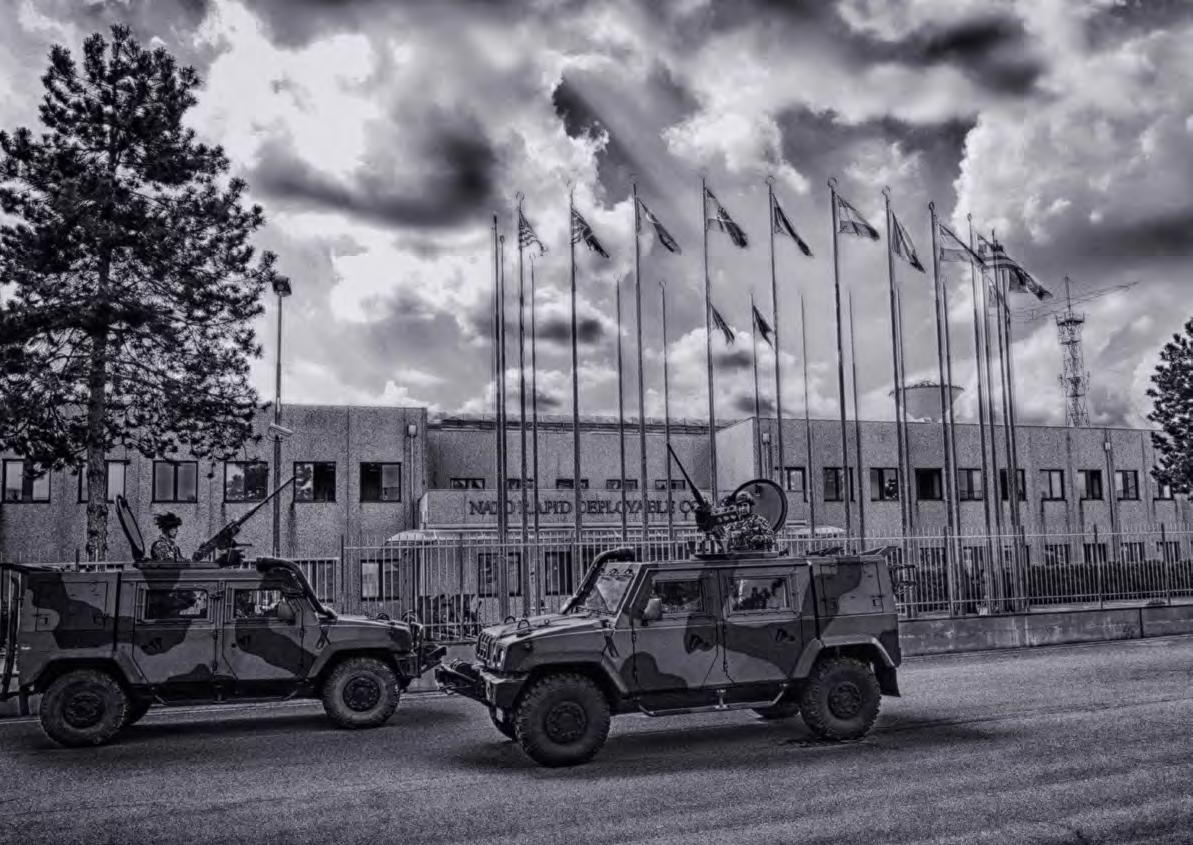
 Brig. Gen. ITA (A) Manlio Scopigno, former DCOS OPS
Brig. Gen. ITA (A) Manlio Scopigno, former DCOS OPS
The year 2015 will be remembered as the NATO validation for the Italian NATO Rapid Reaction (NRDC ITA) in planning and executing functions in a “joint” environment at Operational level; in other words: a “Joint Task Force HQ - JTF HQ Command “. The consequences, which are still operating, were its immediate inclusion in the rotation plan as “Stand by Force” for two years, until the middle of 2016. Since then, only six months separate it from another important validation of the functions of the Land Component Command (LCC), as part of the package of “enhanced NATO Response Forces - eNRF. The current period is particularly full of challenges. On the one hand NRDC ITA exerts every effort to maintain the operational and logistical requirements to ensure its rapid deployment as JTF, especially supporting the activities and procedures, along with the fulfillment of the NATO standards, that have characterized the success of the validation, the so called “Best Practices”. These Best Practices represent what most distinguishes the NRDC ITA Command of all the Graduated Response Forces - GRF and represent the most important skills learned. Also, the process of adaptation to the functions of LCC requires an adjust-
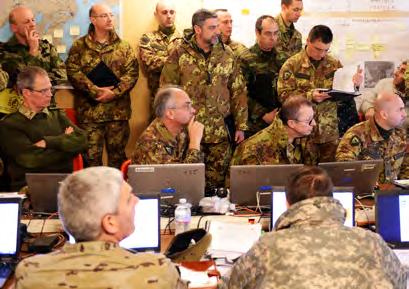
ment of the operating cycle to different functions and different products. These changes cannot be started only at the end of the JTF Stand by Period next year. For these reasons, as early as January, the study of the transition from JTF to LCC, in conjunction with the maintenance of the JTF capacity, was initiated. To provide an overview on how NRDC ITA is facing the transition, one should start right from the most valuable legacy of validation JTF HQ: the Best Practices. The first Best Practice is the structure “three pillars”, in which the classic areas of Operations and of Logistics are alongside with the new one of “Influence”. It was a bold experiment, also undertaken by some other GRFs, which produced remarkable results. The basic concept is that to achieve an effect both kinetic and non-kinetic actions may be taken, and most of the time both taken together, in a carefully measured manner. In the structure of the NRDC ITA HQ it was therefore decided to merge all the cells responsible for the planning and control of non-kinetic actions into a single Influence Division, with the exception of the cells responsible for the development of Targeting, as it is a cross-functional process. The timing and merging of the activities developed by the Operations Division and the Influence Division takes place daily through working groups and boards, of which the important is the Integrated Effects Board. Another Best Practice, also tested by other GRFs, is for the JTF Command to also fulfill the functions of the LCC of the Command and Control of Maneuver Units without a Divisional level command. This ability has led to the adoption of a model called “Integrated”. The result is an internal system for the delegation of Control given to the Deputy Chief
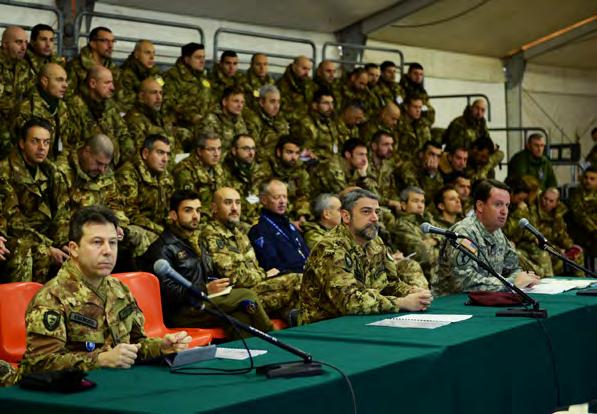
of Staff for Operations - OPS DCOS, and an adaptation of the battle rhythm, including additional meetings and working groups between DCOS OPS and the Commanders of the Brigades, in addition to the staff producing Fragmentary Orders for dependent units. Development for a Host Nation Capacity Building of military activities through the Training, Advising and Assisting included the implementation of Security Force Assistance activities (SFA). This Best Practice, in the absence of an established NATO doctrine, allowed the NRDC ITA to develop some concepts based on the capacity of the HQ in solving the problems according to a functional approach. The ability to perform Knowledge Development (KD) with analysts drawn from the Selected Reserve, highly trained staff who belongs to the civilian world, employed for short periods as military, deserves a special mention. The advantage of using these human resources, rather than personnel in permanent military service, is that they can also bring with them a very useful network of contacts in academia. In the process of transformation from JTF HQ to LCC it is important to consider that the identified capacity as Best Practices must somehow be maintained and adapted to the need. The guarantee of this flexibility is the main effort of NRDC ITA,
and the following aspects have to be considered. With regard to the role of Influence in the Tactical Battle Rhythm of LCC, NRDC ITA must continue to consider the kinetic and non-kinetic actions in both the planning and execution phases, as these activities take place in a short period of time. For the SFA; it must maintain the ability of the HQ to address any issues on Training Advising and Assisting in a cross-functional way. The reference should be the operation of TAAC Commands in Afghanistan as part of Mission Resolute Support. Furthermore, regarding KD; it is a valuable resource that requires maintaining a high degree of professionalism and the ability to integrate staff effectively. Additionally, staff will develop more activities of a tactical nature within the Human Terrain System sphere. In conclusion, the study for the passage of the functions from JTF HQ to LCC requires a considerable labor effort, which must be analyzed according to an operational design comprising several lines of development. Within this context, however, the ability of staff members to adapt their mindset appropriately from an operational to a tactical focus is paramount and relies more on the professionalism of the staff than on following the path of a line of development.


Capt. ITA (A) Giambattista MURA, assigned to NRDC-ITA in March 2015, Staff Officer OPS Current Planner, OPS Division
The NRDC-ITA Command Post Concept workshop took place from 16th to 17th February 2016 in Ugo Mara barracks in Solbiate Olona under the chairmanship of the Deputy Deputy Chief of Staff (DDCOS OPS) Col. Adam Edmunds (UK) Chairmanship and the participation of all Branch Representatives. After having achieved the JTF Certification issued by SHAPE, NRDC-ITA is working on the Command Post Concept, standard procedures, internal instructions validation and refinement in order to contribute to the overarching concept for the Command and Control of Operations. The con-
cept has been intentionally designed to give the NRDC-ITA HQ Commander the operational freedom to tailor the Command and Control (C2) architecture according to the mission requirements, the environment, geography and the Commander’s needs. The current NATO Deployment Model is based on 4 capability blocks: Operational Liaison and Reconnaissance Team (OLRT), Forward Coordinating Element (FCE), Initial Command Element (ICE) and Redeployment Coordination Element (RCE). In broad terms the responsibilities of these blocks are:
1. OLRT. A high readiness reconnaissance and liaison element. The first operational footprint in theatre of


an upcoming operation, tailored to support and inform the planning process by building Situational Awareness (SA), answering in-theatre Request For Information (RFIs) arising from the Crisis Response Planning (CRP) and facilitating some early liaison with the Host Nation (HN) and other in-theatre stakeholders. It is a sort of “Extended Arm” of Joint the Operational Planning Group (JOPG).
2. FCE. A Supporting element to the designated Operational Headquarters (OHQ). It sets the conditions for the deployment of subsequent NATO forces, the establishment of the theatre Command and Control (C2) structure and exploits early engagement opportunities.
3. ICE. It is the first in-theatre C2 capability deployed after the Activation Order (ACTORD) and consists of the minimum suite of joint functions and capabilities required to allow the Commander to exercise both Command and Control from theatre.
4. RCE. It coordinates the redeployment of the Force at the end of mission.
The main purpose of the Command Post Concept workshop was to run a detailed “crosswalk” of the command post standard operating procedures and internal instructions to ensure continuity and to smooth over any conflict and to coordinate and agree on Sea Eagle Exercise’s execution details. The Exercise, which will involve a large part of the HQ, will take place next April. Exercise Sea Eagle (Land) is intended to exercise the NRDC-ITA deployable Command and Control capabilities at Operational level (Joint Task Force), in according with the Command Post Concept including the deployment of the Forward Coordination Element (FCE) and the Initial Command Element (ICE) Capability Blocks, in order to validate the concept and identify area for further refinement.
Exercise Sea Eagle (Land) 16 is based on the SKOLKAN 2.0 scenario, which focuses on the failing state of ARLAND in the fictional SKOLKAN region of northern Europe with many operational dilemmas that the Training Audience would need to address in an actual real-world operation.
The Exercise Objectives of Sea Eagle (Land) 16 are:
1. Train Permanent Headquarter (PHQ) staff on CP Concept and Transfer of Control (TRANSCON) process;
2.. Validate overarching Command Post Concept and harmonize supporting internal instructions and procedures;
3. Increase Senior Leader’s (ACOS & DCOS) understanding of Command Post Concept.
4. Train CJOC Team (PHQ) and Early Entry Command Post CJOC members;
5. Exercise Transfer of Control (TRANSCON) process;
6. Exercise Command Post Design of Theatre Command Post (TE CP), Joint Logistic Support Group Command Post (JLSG CP), and Early Entry Command Post (Physical layout, C2 architecture, Manning);
7. Test information flow between PHQ and EE CP. Exercise Sea Eagle (Land) 16 surely will be a successful training event to consolidate the procedures and the experience as a JTF HQ role. It also represents a “bridge” between the Trident Jaguar 15 Exercise conducted in Stavanger (Norway) last April 2015 and the next major training event (Eagle Meteor 16) in November 2016 in Southern Italy (Torre Veneri - LECCE) where NRDC- ITA will conduct a Command Post Exercise (CPX) combined with a Live Exercise (LIVEX). We are in transition and looking at how best to maintain proficiency and readiness for potential activation.


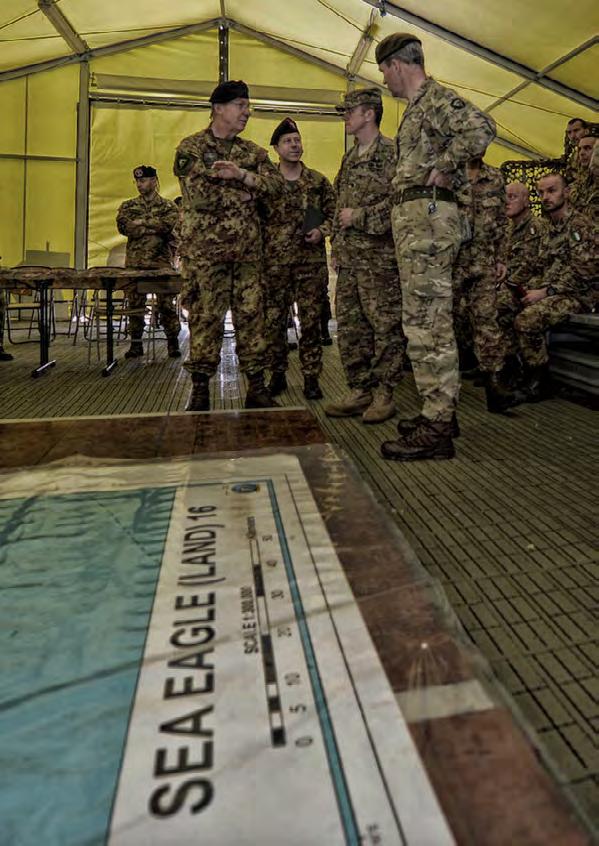
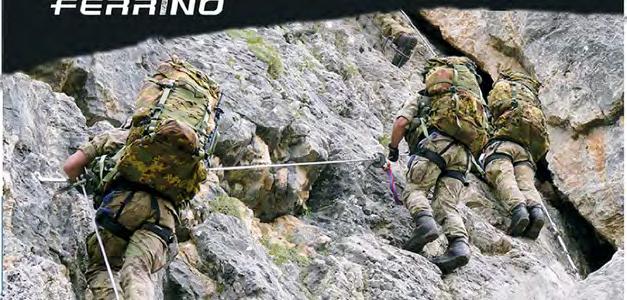

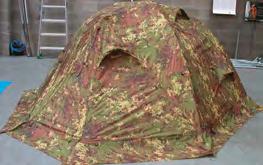

The unique story of a brand that has been synonymous with mountains, adventure and open-air since 1870
Once there was an idea. It was 1870 when Cesare Ferrino began industrial-scale production of the formula for waterproofing fabrics that he had discovered, tried and tested and perfected over the years. It was a winning idea.
This marked the start of the Ferrino story. More precisely, the story began in the company’s Turin store at 107 Via Nizza, centre of production for waxed cloths, tarpaulins, and army tents as well as the only place to go if you were looking for avant-garde technology.
As well as the outdoor industry, for some years Ferrino has been
making progress in new specialist fields. With a line of products specially developed for emergency situations, today Ferrino is a supplier to the United Nations, Caritas, Red Cross, Italian Civil Protection, National Mountain Rescue Corps and all the major humanitarian aid organisations.
At the same time, it is also expanding quickly into the armed forces equipment industry. In fact, Ferrino supplies the Italian, French and English Defence Ministries, for which it develops and manufactures special equipment made directly to customer request.
and programme to be ready for the NRF

Maj. ITA (A) Luca GIOVANGIACOMO, assigned to NRDC-ITA in September 2013, staff officer within J7 Branch (OPS DIV), exercise planner has been along the 2014 and 2015 the Co-OPR for Exercise TRIDENT JAGUAR 15, the validation exercise for NRDC-ITA as JTF HQ. Now is facing the new challenging in the training of NRDC-ITA as LCC for the eNRF 18
After the Wales Summit held in 2014 the Heads of State agreed a Readiness Action Plan (RAP) which articulated how the Alliance should adapt to improve its readiness and responsiveness. This included enhancement of the NATO Response Force (NRF) to better meet the new security issues affecting Europe and the sphere of the Alliance. It is worth recalling that the employment of the NRF may be just one part of a wider NATO military counter to emerging threats. The value of an enhanced

NRF, and specifically the Very High Readiness Joint Task Force (VJTF), in Collective Defence is in re-establishing the strategic continuum of NATO deterrence. To take its place in the continuum, the enhanced NRF will offer assured, well trained, agile and capable combat forces held at appropriate readiness. These significant changes in the NRF concept resulted in adjustment and adaptation of the future exercise concept and programmes. The NATO Command Structure (NCS) Commanders proposed that the cur-
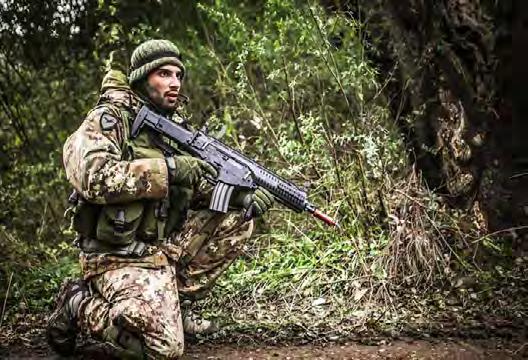
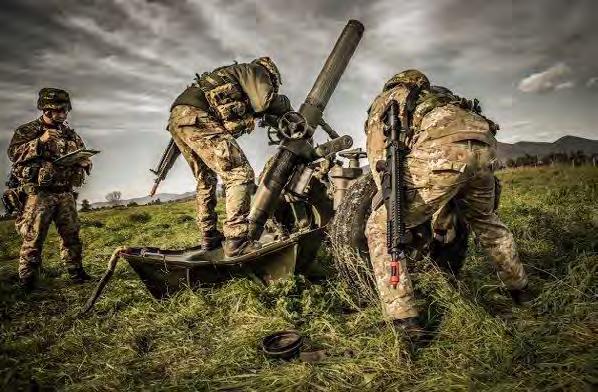
rent NRF training model is to be retained as the basis for the future model, adjusted as recommended below, that will see a progression through a Force Readiness Mechanism (FRM) of Stand-up, Stand-By and Standdown years. The first big change is for the two Joint Force Commands (JFCs), as possible NRF Commanders, to alternatively deliver oversight of the training progression of the NRF through Stand-Up and StandBy years.
In this context, Italy offered NRDC-ITA HQ as the Land Component Command (LCC) for the NRF 18 force package, and the VJTF (L) Units for years 20172019 (Stand-up, Stand-by and Stand-down).
While no changes are proposed to the current unit level training (that remains a national responsibility where NATO is tasked to monitor the preparation), at Component Level some changes have been applied. The Components will undergo a Certification through a LIVEX (labelled Arrow, Ledger, Mariner and Sword for the Air, Land, Maritime and Special Ops domains), with NRDC-ITA HQ scheduled to conduct, in 2017 for its Stand-Up Year Training, Exercise BRILLIANT LEDGER. In particular the training content for NRF will now primarily focus on Article 5, including high intensity warfighting. Consideration will also be gi-
ven to combining these NATO Component LIVEXs with significant national LIVEXs, where feasible and appropriate, to maximise interoperability training and saving HQ and National resources.
As a consequence Ex BRILLIANT LEDGER, as agreed with the Italian Army General Staff (IAGS) and Joint Force Command Brunssum (JFC BS), will be split into two parts as follows:
Part 1 will be a LIVEX for the ITA VJTF Unit under CREVAL. On this occasion NRDC-ITA HQ will play the LCC role as higher HQ of the VJTF Unit. Part 2 will be a CPX where NRDC-ITA in LCC role will be under CREVAL. In order to allow NRDC-ITA HQ to receive valuable training JFC Brunsumm will play the JFC Role as Higher HQ while the VJTF Unit will play as the subordinate Unit to the LCC.
During its Stand-By year, the NRF Force should conduct two exercises to both demonstrate its responsiveness and contribute to assurance measures across the full extent of SACEUR’s Area of Responsibility (AOR). These new exercises will involve the use of real-world detailed procedures and represent those types of exercises that have not been conducted throughout the Alliance for some time. In detail this means that the NRF Stand-By training (in 2018 for NRDC-ITA

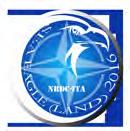
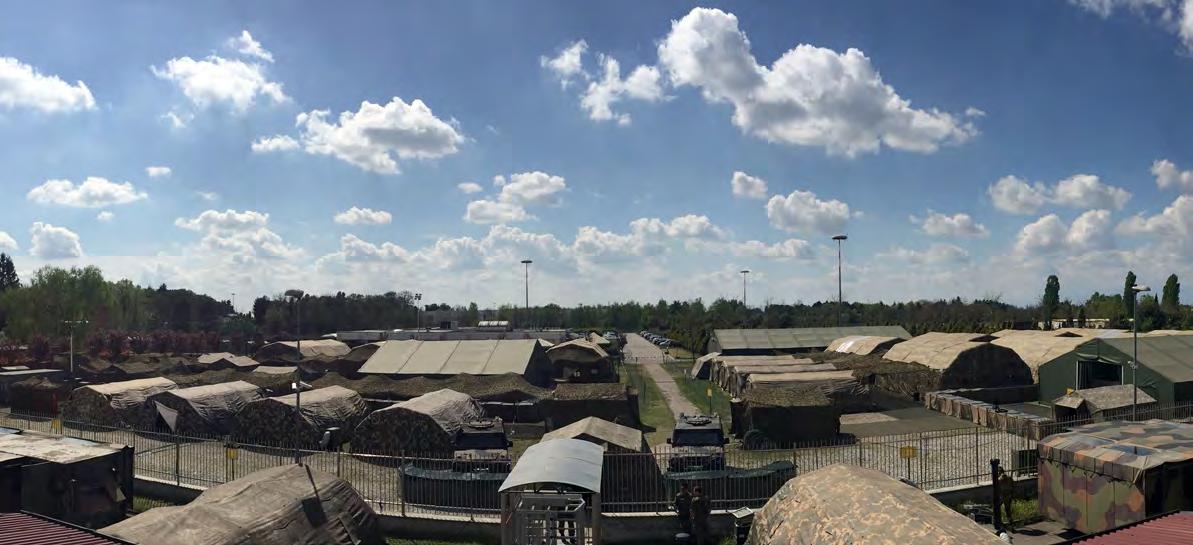
HQ) should be achieved through two new short-notice exercises: a Readiness Exercise (ALERTEX) and a Deployment Exercise (DEPLOYEX). These two will be part of the Ex BRILLIANT/NOBLE JUMP series where the Ex will be labelled “Brilliant” or “Noble” in accordance with the JFC Officer Scheduling the Exercise (OSE) responsibilities (BS or NP).
JUMP Part 1 (ALERTEX) will focus on activating and preparing the Land Component Command (NRDC-ITA) and the subordinate VJTF(L) Unit. JUMP Part 2 (DEPLOYEX) will focus on deployment of activated forces. The Minimum Military Requirement (MMR) is the VJTF(L) HQ and the Spearhead Battalion. In addition to the aforementioned exercises NRF forces will conduct continuation training through a Readi-

Training Audience will be broadened to include elements of the JFC, the C2 for the VJTF, JLSG and relevant NFIUs.
It is proposed the VJTF forces will maintain their readiness at 30’ days NTM through the participation in national exercises as determined by troop contributing nations.
In order to practise, SHAPE the JFCs and SSCs in their ability to exercise command up to a Major Joint
Operation Plus (MJO+), a new three-yearly exercise, labelled TRIDENT JAVELIN, is being developed: the first iteration is planned for 2017. The general framework and requirements for such in important exercise are at the moment under discussion among the main stakeholders (ACT, SHAPE, JFC BS and LANDCOM). However, as a first attempt, Trident Javelin will be a three level exercise (CPX) in a NATO Article 5 Operation setting, involving high intensity operation with both the NATO Command Structure (NCS) and NATO Force Structure (NFS), In this context NRDC-ITA HQ involvement in the Exercise is predicted to be a response cell playing as subordinate Corps HQ under LANDCOM (LCC) Command.
The number and type of Exercises that NRDC-ITA will conduct during the Stand-Up and Stand-By Years in preparation for the NRF 18 role clearly illustrate how much importance NATO is giving to the training and exercises as part of available response measures. Furthermore, these events will serve, more in the longer term, to provide NATO with the chance to increase its visibility all around the world demonstrating the capability to maintain security and stability.Of course the success of this new training concept depends on the commitment of forces and, finally, on the countries being part of the Alliance. The right equipment and additional financial resources are now required to face the new challenges within the Alliance.


NRDC-ITA is proving to be at the forefront in the implementation of the Knowledge Development (KD) concept within its own structure. The KD procedures and initiatives at the headquarters have contributed to enable it in reaching the ability to operate at the Joint level. Since the beginning of 2014, the KD team devoted much planning and preparation to experiment the interaction with Non NATO Entities (NNEs). This initiative, perhaps unique, was put in place during the Exercises Eagle Joker 14 (EJ14) and Trident Jaguar 15 (TJ15), respectively the national and NATO JTF
validation. This experiment was conducted with the direct involvement of two universities (teachers and students) who participated and interacted in videoconferences with the Staff of NRDC-ITA on topics related to the exercise scenarios. The two Universities, with which NRDC-ITA maintains close contact, are:
- Jagiellonian University, faculty of Political Science and International Relation (Poland), which was in charge of the political and social dimensions of the crisis;
- LIUC University Carlo Cattaneo, faculty of economy, in Castellanza (Italy), which was in charge of the economic dimension of the crisis.


The two Universities developed different approaches to the experiment. The faculty of Political Science and International Relation at Jagiellonian University, had a particular interest for any topic related to NATO. For Professor Michal Matyasik, the participation in this activity was an occasion to better understand the new NATO concepts of KD and Comprehensive Approach (CA), and their related procedures. In a different way, the LIUC University of Castellanza took this experiment as an educational opportunity for its students, and attended this activity with a strong team composed of two Professors (Gianfranco Benedetto and Liana Minelli) and a dozen students. Before the exercises both Universities were made aware of the scenario, while during the active phase they were updated on the evolution of the crisis, providing them a general understanding of the crisis through the media, as it usually happens in a real case . During the interaction that took place in the ambit of EJ14 and TJ15 the two Universities’ representatives treated topics inherent to the crisis scenarios, and gave their points of view to the KD team about the general situation and specific topics related to the political, economic and social dimensions of the fictitious engagement spaces. The means used by the KD team to interact with the NNEs represented another peculiarity of this experiment : as for the VTCs, the team used freeware software that made the interaction simple, economical, and especially manageable by anyone and from anywhere in the world. During both exercises the interactions via VTC with each University lasted about one hour and were considered of great value for NRDC-ITA, not only for the content of their analysis and assessment, but also for the chance this experiment gave to NRDC-ITA of
testing the procedures for the involvement of NNEs into the PMESII analysis during the execution phase of the operations (security procedures included). This also gave to NRDC-ITA the evidence of the amazing potential and importance of the civil-military interaction in the sphere of the Crisis Management. Knowledge Development is a new NATO concept that origins from the adoption of the wider CA. The CA concept was officially adopted with the new “NATO Strategic Concept” in October 2010, that foresaw the reform of the NATO command structure and so the reform of the NATO forces. In particular, the New Strategic Concept stated that NATO will continually monitor and analyze the international environment to anticipate crisis and, where appropriate, take active steps to prevent them from becoming larger conflicts. In line with these political tasks a KD capability is required to effectively support situational awareness that is the basic element for the planning, execution and assessment phases of operations in a CA. The CA itself foresees a deep interaction between military and civil dimensions during the planning and conduct of operations, through the exchange of information and lessons learned, the conduct of common phases of training, the enhancement of cooperation activities , the coordination of public messaging and the involvement of the non-military dimension into the military planning. For NATO the CA concept is not only the above list of actions, but especially an overall mindset that foresees an open-mindedness, both for cooperation purposes and the understanding of the different human dimensions of the operational environment. The Knowledge Development responsibility is to develop a comprehensive situational awareness and understanding of the operational environment, analyzing the political, economic and social dimensions inside


the PMESII framework (which includes the political, military, economic, social, infrastructural and information dimensions) that is developed through the analytical process of the System of Systems Analysis. Considering the innovations introduced by the CA concept, the KD team is able to reach a comprehensive situational awareness through the exchange of information with the Non NATO Entities (NNEs), like, for instance Institutions, International Organization, Governmental Organizations, Non-Governmental Organizations, Centres of Excellence, Academia, etc. This kind of civil-military interaction allows the decision makers (military Commanders and their staff and civilian officials) to: - have a holistic and comprehensive understanding of the engagement space; - be aware of the possible effects that the political, economic, military and civil actions can have on the different PMESII systems; - identify the most effective actions to be taken to achieve the desired effects. The System of Systems Analysis is the key process that allows a real and comprehensive situational awareness. The two concepts are interdependent and their illustration enables a deeper comprehension of the KD concept. The System of Systems Analysis is a continuous, iterative and collaborative process that is conducted by the Knowledge Development team in close co-operation with Subject Matter Experts (SMEs) belonging to all the HQ’s branches and SMEs belonging to the NNEs as required. The situational awareness is the human perception of all available elements of information related to a specific situation: it allows a more holistic and informed interpretation of the reality and contributes to all phases of the process by providing a holistic understanding of the environment. Therefore the System of Systems Analysis approach facilitates the improvement of the situational awareness passing from a simple perception (i.e. the initial understanding of the general situation based on the relevant situational elements and their current state ) to the comprehension (i.e. the awareness of how the situation will impact upon own objectives and goals).
As a consequence this shift consents the projection towards a more enhanced understanding in order to make consistent assessments of the outcomes related to a potential action within the operational environment.

The System of Systems Analysis has proven to be particularly useful in analyzing and understanding problems in complex operational environments. Rather than analyzing the different Systems (and related elements) separately, the projection (which represents the highest level of situational awareness) , is reached analyzing them all together, thus gaining a comprehensive understanding of dynamics, capabilities, behaviors and interactions of the various elements within the engagement space. Due to modern threats, the interaction between military and civil di-
mensions is paramount to reach such a situational awareness and can make the difference between the success of the mission and its failure. The civil military interaction of the actors involved into the crisis management is not an option but a real need to face the complexity of modern international scenarios; at the same time it represents a good way to optimize the shortage of human and economic resources. For the sake of all actors and for the aims of a joint intervention in an area of crisis , it is necessary to establish a close interaction between civil and mi-
litary dimensions well in advance, i.e. since peace time and during the training phases, in order to adequately develop the collaborative effort which will be implemented during the execution phase. This will enable the achievement of common goals in a more quickly, effective and, above all, safe way.


As I write these sentences, my tour of duty at the Headquarters NATO Rapid Deployable Corps in Italy is coming to its end within weeks, after four exciting and meaningful years. I started working at the Headquarters as Deputy Chief of Staff Combat Support Division in a demanding period in July 2012, when the Headquarters was in the middle of a period of preparation for an operational deployment in Afghanistan. The division at that time included six branches with more than 90 staff overall. Within six months about two thirds of the division’s members deployed, while the remaining staff started to work to change the conditions, directives and mindset from a land to a joint-focused operational view. NRDC-ITA HQ and the entire NFS experienced the increased magnitude of military involvement in Crisis Response and Stability Operations as well as the complex interaction between the involved stakeholders, both military and civilians. The ascendance and centrality of Information/Communication domain in modern warfare determined the increase, as a fact, of the importance of the coordination of all the desired effects in support of the Commander’s mission. Influence Division has been created exactly with this purpose. The road from land to joint, from combat support
to influence, was long and hard. During Exercise EAGLE BLADE in February 2014 the influence concept was tested for the first time, integrating the staff back to the HQ’s business right after the operational deployment. Further development was achieved in Lecce during Exercise EAGLE JOKER in October 2014, while the influence concept was finalized during our NATO certification exercise TRIDENT JAGUAR in Stavanger last year. The same year, in 2015, the Influence Division was established officially in our structure as the third pillar of the HQ, but we still have a lot to do. The influence concept now is getting well known and popular within the NATO command and force structure. To help this process, the organisation of the first Influence Conference in Solbiate Olona earlier this year was a very important step towards sharing information and views with our sister HQs.
I am very glad to have had the opportunity to work once again in a rewarding multinational environment, and to enjoy Italy’s warm hospitality and engage in some travel and leisure activities while posted to NRDC-ITA.
I am leaving as Deputy Chief of Staff Influence Division from a certified Joint Task Force Headquarters, which has already completed one year NATO stand-by duty for Smaller Joint Operations with a Land focus. I am convinced that the Influence division staff’s dedication and commitment will result in a successful certification exercise in 2017 for Land Component Headquarters.

Thank you very much for your continued support and contribution. I wish all of you prosperous years at your work and happiness in your private life. God bless all of you!

NRDC-ITA is performing several activities in order to spread the Influence approach and perspective among its Staff at any level and in order to improve its capabilities and knowledge on Influence pillar. In particular during the first semester of this year this HQ hosted two very important events, the NRDC-ITA 1st International Influence‘ Conference and NRDC-ITA 1st Targeting Workshop (TGT WS 16)

During the last decade NATO experienced the increased magnitude of military involvement in Crisis Response and Stability Operations. The complex interaction between the involved stakeholders, both military and civilians, determined the ascendance and centrality of Information/Communication domain in modern warfare. Therefore NRDC-ITA HQ and the entire NFS realized the increase, as a fact, of the importance of the coordination of all the desired effects in support of the Commander mission. INFLUENCE pillar within NATO Forces Structure (NFS) HQs has been created exactly with this purpose.
After a test period, the INFLUENCE Division became a reality in our structure in 2015 as the third pillar of the HQ. The influence concept is finally getting well known within the NATO Force Structure. To help this process, the organisation of the 1st NRDC-ITA International INFLUENCE Conference at NRDC-ITA HQ in SOLBIATE OLONA (VA) on the 6th and 7th April 2016 represented a very important step ahead for the entire INFLUENCE Community to achieve NATO common goals.
With the aim to enhance INFLUENCE perspective in Operations and to share experiences and lessons learned after the transformation and validation process to JTF (HQ), the main topic of the conference has been “The ascendance and centrality of the Information/Communication Domain in Modern Warfare”,


according to the INFLUENCE pillar‘s role. It represented an important and timely opportunity as well as a main event for NRDC-ITA HQ, being the first on INFLUENCE Pillar.
The event attracted high-profile authorities from both the NATO community and the Host Nation highlighting the significant value of the event.
After a very interesting discussion on Social media operations and analysis, the conference concluded with a special guest speaker, Michelangelo CONOSCENTI, full professor and chair of english linguistic and analysis of military and political discourse at the University of Turin. During a very interactive period with the audience, consisting of conference attendees and NRDC-ITA staff, Prof. CONOSCENTI explained deeply the concept of intercultural coomunication and negotiation highlighting how the consideration of any effects are important in an effective interaction, giving examples from propaganda and advertising all around the world, and stressing on how to drive those effects to desired goals in advance.
A panel discussion on the main NATO present efforts completed the conference convincing the attendees on the conclusion that a new community was established within NATO and its importance will increase in accordance with NATO challenges.
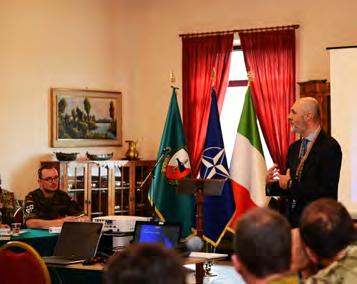

Following the Allied Command Operation TARGETING Conference in December 2015 and within a series of Conferences and Workshops of the INFLUENCE Division our HQ conducted its first Targeting Workshop to promote discussion of relevant targeting challenges in an ever-changing security environment.
It was held at “Ugo MARA” Barracks in Solbiate Olona, Italy, the Headquarters of the NATO Rapid Deployable Corps Italy (NRDC-ITA), commanded by Lieutenant General Riccardo Marchiò. The aim of the Workshop was to contemplate Targeting in a broader context, in particular the challenge of Hybrid Warfare and to share lessons learned to establish a consensus on the main areas where further work is required in order to meet current challenges to NATO.
The workshop was not focused for solely the Targeting Subject Matter Experts (SMEs). It also seeked to engage with those directly involved with the Targeting process, in particular those who would either attend the Commander’s Joint Targeting Coordination Board or its equivalent in other Headquarters. The Workshop attracted high-profile Subject Matter Experts from the NATO community (NATO Command Structure and NATO Force Structure), Italian Army as well as Italian Air Force and renowned speakers from civilian organizations:

President, The Potomac Foundation Research Professor, Georgetown University
At the request of the Ukrainian Government, between 2014-2016 he has conducted 18 visits to the combat zone operating with front-line units for over 150 days, and identifying “lessons learned”.

Dr. Melzer is the Swiss Human Rights Chair at the Academy of International Humanitarian Law and Human Rights in Geneva, SUI, where he has been teaching since 2009, including as the Swiss Chair of International Humanitarian Law (2011-2013).
In the end the TARGETING Workshop 16 was a busy and productive event, lessons learned as well as new concepts have been presented consequently the audience was able to attend and discuss very interesting topics and concepts.
The aim of the workshop has been fully achieved, main areas where further work is required in order to meet NATO’s current challenges especially with regards to Hybrid Warfare as well as the Information/Communication Domain in Modern Warfare have been identified and initial concepts and ideas have been discussed.
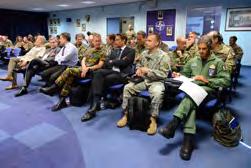

S2nd Lt. (Res) ITA (A) Margherita
NACCARATI, assigned to NRDC-ITA in September 2014, Webmaster and Social Media Manager of Public Affairs Office
ocial media is a powerful communication tool, but it goes beyond just using the tools . It is important to understand the tools and their benefits and the sometimes dangerous ramifications. What is social media?
Social media is the collective of online communications channels dedicated to community-based input, interaction, content-sharing and collaboration. It represents a shift in the way we as a culture communicate.
It gives you the ability to communicate with larger audiences faster and in new ways.
NRDC-ITA is ready, willing and able to contribute to implementing NATO Stratcom guidance (ACO directive (AD) 095-003) with the aim that SOCIAL MEDIA is an extension of communications and PA activities.
This is because social media is a cheap, effective and measurable form of communication.
Social media is becoming an increasingly important tool for keeping families and soldiers connected with each other, for sharing information about the Headquarters, for sharing photos and video that communicate the Headquarters culture and the HQ structure, and for broadening and deepening the understanding of NRDC-ITA’s role with the external audience, social media can explain our mission and generate additional support, temper opposing views, and solicit ideas from external audiences that may help NRDC-ITA develop itself.
The NRDC-ITA values can be seen through its social media footprint.
Social media is an opportunity to instantly reach out and connect regardless of time, space and distance. Communication is the most powerful weapon for those who can make use of it. Today social media is deci-

be regularly reviewed to ensure organizational objectives and audience needs are being met. There are a wide range of metrics that can be analysed and software programmes that can measure various impacts. Do not just focus on total numbers of followers, but rather seek to measure the level of engagement and interaction occurring with audiences. Track increases in followers and interaction and try to ascertain what factors were behind any increase or decrease in performance. Finally, attempt to tailor your stategy and methodology to incorporate lessons learned and avoid previous mistakes. Personnel employed in social media positions should receive formal training in measuring the effectiveness of online campaigns if practicable. Such training is available via numerous civilian workshops. The OASIS framework is a method to define the Nrdc-ita strategy with 5 steps to integrate social media into daily business.
PA objectives.
We use facebook to engage social media communities in conversations related to our activities and operations while communicating key themes and messages to internal and external audiences.
Twitter can increase and promote follower loyalty, linkedIn can build our Headquarters to help establish our policy;
Google plus can boost SEO (Search Engine optimization) value of our online content to help increase visibility;
Flickr and Youtube can share photos and video that communicate our HQ structure and our HQ culture.
The NRDC-ITA narrative is projected through articles, images, and links.
sive in determining success.
Not only for communicating, but also knowing how to communicate; Communicating in different ways for different audiences.
Communicating for Army families and for internal and external stakeholders.
The Nrdc-ita website and social media have been created with a clear strategy and have been created according to ACO DIRECTIVE AD95-003:
6-2 Initial Steps. The first step in implementing social media within a unit or headquarters should be to develop a social media strategy that clearly articulates objectives, authorities, resources, tools/methods to be employed and measures of effectiveness.
The strategy must be aligned with STRATCOM objectives, the PA communication plans, Commander’s intent, and the overall themes and messages from ACO and NATO.
Social media administrators should create a plan that best fits their goals and communicates to the information needs of their particular audiences.
For developing and implementing this plan, social media administrators should:
a. Review social media guidance from NATO, ACO and the subordinate commands.This guidance provides the basic information needed to fully implement a social media strategy. Social media experts working within PA may request the assistance of other personnel that have social media experience to assist with certain tasks.
b. Using the social media platforms that best meet the organization’s goals and needs to create a social media presence. It is best to start with a small number of platforms and execute an effective campaign, rather than to try to have a presence on too many platforms.
c. Register all social media sites with the ACO PA Office Social Media Section
d.Maintain all social media sites with up to date and relevant information by using feedback from the audience and adapting to the Commander’s intent and the organizational goals
6-3 Measures of Effectiveness. Social media strategies should
OASIS is an acronym and stands for Objectives – Audience- Strategy – Implementation and Sustainment.
Our use of social media (Facebook, LinkedIn, google plus, Twitter, Flickr and Youtube) supports the concept of sharing to communicate. All of these platforms are aligned and support ACO’s overall STRATCOM and
#Wearejointandcombined is the NRDC-ITA hashtag.
This creates a category, or a theme. Any combination of characters led by a hash symbol is a hashtag, and any hashtag, if promoted by enough individuals, can “trend” and attract more individual users to discussion.
Another important emblem is the NRDC-ITA logo. This is Command branding , a visual identity for the
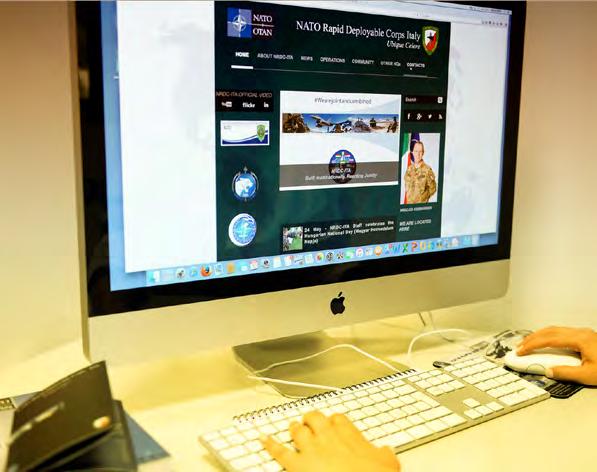
integrity of the brand when used consistently and correctly across all communications.
“Only what can be measured can be improved” . We have to be ready to interact with our audience because the main mistake made by organizations when entering into social media is not to really know their objective with the social initiative, so the social engagement starts backwards by first using the tool without the proper strategy – Brian Solis (a digital analyst, anthropologist, and also a futurist. In his work at Altimeter Group, Solis studies the effects of disruptive technology on business and society) tells us that social media is about
sociology and less about technology. To be successful , in fact , companies need to focus not only on profit but to develop capacity for empathy to understand what stakeholders think and what they need.
But remember: social media is an important part of our society and our freedom but our enemies also use social media.
For this reason military and civilians in Defense institutions need to understand and be able to make efficient use of social media.

The conversation Prism is a visual map of the Social Media landscape. It is a 26 slice cake , a chart developed by Brian Solis since 2008 which described some of the social media and web 2.0 companies in vogue at the moment . It is a map of the social scene and a digital ethnography study that tracks the dominant social networks and the most promising and organizes them based on how they are used in everyday life. The conversations are taking place with or without you and this map will help you visualize the potential extent and pervasiveness of the online conversations that can impact and influence your brand.




Lt. Col. ITA (A) Sergio INVIDIATO, assigned to NRDC-ITA in September 2014 as SO1 Chief LOG. He is responsible for monitoring and coordinating logistic operations of the JLSG and he leads and co-ordinates the activities of the Logistic Branch
All Alliance logistic concepts of operation depend upon the interpretation of agreed logistic principles through established logistic command and control (C2) structures. These principles recognize the importance of a number of different support methods including national provision, host-nation support (HNS), contractor support to operations (CSO) and multinational cooperative logi-
stics. The JLSG is an executive tactical level logistic formation responsible for the execution of operational logistic plans and reporting to the operational HQ. As such it is the key organizational element of the agreed NATO conceptual approach to the direction and coordination of logistic support methods in order to provide for integrated theatre-level logistics. The JLSG approach is designed with rapidly deployable
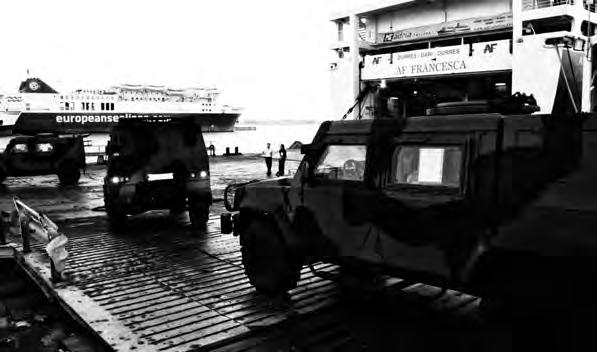
forces and flexible C2 structures in mind; each necessary to bolster the NATO Response Force (NRF). The JLSG HQ will be task organized to match the mission. Multinational joint theatre logistics addresses the requirements for and the organization and functions of logistic support across the spectrum of current and potential NATO operations. To achieve the versatility and agility called for by the operational requirements of deployed forces requires greater unity of effort from deployed nations. This should be supported to the maximum extent possible by practising collective responsibility to bring about increased multinational joint logistic cooperation, so reducing the redundancy in capabilities inherent in multiple national or component support contributions. Under this construct, as the NATO commander assumes more responsibility for theatre-level logistics, to include greater reliance on multinational solutions, this should allow a corresponding reduction in the requirements placed upon national support elements (NSE), so reducing their size and the overall logistic footprint. The logistic support concept for NRF operations establishes the basis for achieving these ends.
From 1st January 2016 NRDC-ITA Joint Rear Support Command has assumed the structure of Joint Logistic Support Group in line with the Logistic Concept as mentioned above, ensuring an organization, both operational and tactical, able to construe theatre logistics, through a tailored and versatile structure that can interact at multinational level.
In order to be in line with the newly formed organization and to comply with NATO Theatre Logistic Concept, the newborn JLSG has perceived the need to redact a guideline focused on specific JLSG expertise and experience aimed in providing to all its own personnel and to external personnel that deals with NATO Logistics the essential guidelines to cope and solve all the related issues. Specifically, the Handbook is a landmark to all personnel assigned to this Command as Peace Establishment (PE) or augmentee; since not everyone is born as a “Loggie” (nickname for logistician) or deals with Logistics, he/she can find in the Handbook the tools for confronting himself/herself with matters concerning multinational and theatre logistics.




The Handbook provides essential notions on the basic principles of theatre logistics, organization and how to perform/execute at operational and tactical level. This guide, besides combining simultaneously doctrine and related practical activities alongside with pragmatic examples, is the only one of its kind amongst the multitude of existing NATO publications and documentations. Currently, the handbooks dealing with JLSG topics are mainly focused on the transformation process from Rear Support Command to Joint Logistic Support Group, developing how every single Command does, exploiting all available resources for accomplishing its own transformation process. Now we are one step ahead. This Handbook has been redacted with the full cooperation of all the Offices of NRDC-ITA linked to operations with JLSG, in particular: J4 (Logistics Branch), J6 (Communication and Information System Branch), JMED
(Medical Branch), JENG (Military Engineer Branch).
The handbook is structured with a foreword, by the JLSG Commander, an introduction, 3 chapters (NRDC ITA JLSG organization and structure, Crisis Response Planning (CRP), NRDC ITA JLSG support to operations, and some annexes to cover the practical parts: command and control (C2), personnel and augmentation, JLSG liaison and coordination matrix, mounting and deployability, Joint Logistic Operation Center (JLOC), Command Post Layout , battle rhythm and boards / working groups, Communication and Information System (CIS), Information Management, RSOM and movements, Sustainment, theatre medical support, theatre engineer support, report and returns , recognized logistic picture (RLP), abbreviations and acronyms and the references at the end. In conclusion the JLSG Logistics Handbook aims to introduce logisticians at operational and tactical level to some of NATO’s basic principles, concepts and the organizations which they will encounter in the course of their work but mainly to deal with the “know how” aspect of LOGISTICS. This Handbook is not a formally agreed document, and should not be quoted as a reference. It does not necessarily represent the official opinion or position of NATO, the Nations, Commands or agencies on all the policy issues discussed, nor does it attempt to examine current issues or provide answers to the problems that logisticians will face in the field - these will change over time and circumstance. Be curious and enjoy the reading!!!

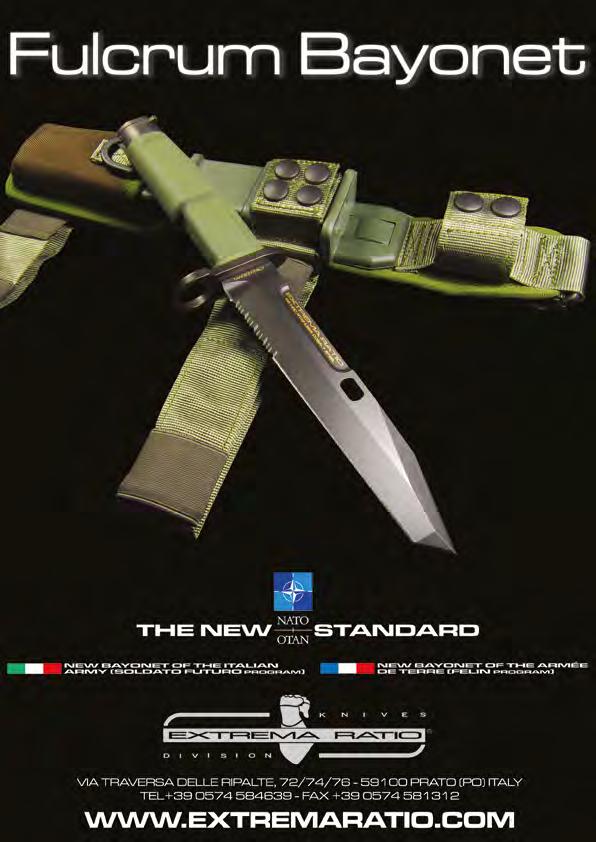 Photo credit: NRDC-ITA PAO
October 2014, Lecce (South Italy), “Torre Veneri” Training Area. Exercise Eagle Joker 14: Staging in practice
Mission tailoring of JLSG
Photo credit: NRDC-ITA PAO
October 2014, Lecce (South Italy), “Torre Veneri” Training Area. Exercise Eagle Joker 14: Staging in practice
Mission tailoring of JLSG

Capt. ITA (A) Giuseppe AJELLO, assigned to NRDC-ITA in November 2015, as Joint Logistic Support Group (JLSG) Staff Officer Movement and Transportation Operations
RDC-ITA Headquarters in Solbiate Olona hosted the 3rd annual NATO Joint Logistic Support Group (JLSG) Conference from 11-12 May 2016; presenting a successful attendance of 58 attendees (19 countries represented) coming from the large majority of NATO Member States, Framework Nations HQ, NATO Command/ Force Structures and Agencies together with SHAPE J4 Representatives chairing the Conference. NRDC-ITA and other NFS Headquarters selected representatives shared their experiences on Logistic Command and Control architecture achieved following the Joint Task Force HQ validation process. “It is important not to forget the appropriate logistic support if we want to achieve operational objectives” – Maj.Gen. Giovanni MANIONE, NRDC-ITA Chief of Staff, said – “in this HQ we are very much aware of the significance of logistics and the important developments occurring among national and NATO organizations. It is of paramount importance to adapt and be ready to react to any change”.
This conference is the first to be held after the recent promulgation of the Standing JLSG Implementation Plan. It proved to be an excellent forum for NRDC ITA HQ and participating NATO bodies to discuss the development and implementation of the JLSG role within the new, enhanced NATO Response Force (eNRF), implemented after the NATO Wales Summit 2014. An annual Joint Logistics Support Group (JLSG) Conference is the appropriate mechanism to review all aspects of JLSG implementation. Hosting the Conference has been a first-rate information sharing opportunity for the NATO logistic community’s sectoral enhancement and to provide visibility to NRDC ITA within the NATO logistic arena. Furthermore, in light of the future preparation and commitment to eNRF 18, this conference has been of particular in terest with respect to the Readiness Action Plan implementation and test-bed exercises, the role of SJLSG, expeditionary JLSG, NATO Force Integration Units (NFIUs), Multinational Corps North East (MNC NE) and Multinational Division Southeast (MND SE)


within the Article V operations and collective defense. The JLSG provides capabilities to command, control and coordinate the joint theatre level logistics and assumes responsibility for both integral elements and collocated functional logistics elements and organizations from the Components whenever nations provide sufficient Command and Control authority over logistics forces to the Joint Commander. The JLSG falls under direct authority of the Commander of the deployed Joint Task Force with a relation of coordination with the other components (land, air, maritime, Special Forces). JLSG modularity allows the tailoring to the specific mission and its flexibility provides a scalable organization to match the operational requirements. The JLSG plays a significant role in almost every expeditionary deployment. As the force is tailored to the mission, logistics is as well. Logistic support to operations is to be considered on the basis of options that run from the lowest level of commitment to the full deployment of a Joint Force. The overall purpose of establishing the JLSG is to enhance the ability to control and coordinate the theatre-level / logistics, including medical and engineer through a combination of directly assigned units and collocated functional logistic elements; the JLSG HQ will exercise Operational Control (or the Command and Control relationship granted by the sending nation) over its assigned units, Tactical Control of units undergoing Reception Staging and Onward
“It is important not to forget the appropriate logistic support if we want to achieve operational objectives”
Movement (RSOM), and as a minimum, logistic control as the lowest degree of command and control over the assigned National Support Elements (NSEs). As part of this, it is envisaged that theatre logistic operations will be grouped together as far as it’s practicable, with NSEs (preferably) collocated in the Theatre Logistic Base (TLB) with assigned units and others logistic units. The JLSG is also responsible for providing Theatre Recognized Logistics Picture (RLP) to the Joint Task Force (JTF) Commander. These two days of brainstorming briefings and lively discussions facilitated to attain a common understanding on the current JLSG HQ implementation status, concerns and challenges, promote common situational awareness within JLSG community on various initiatives/ projects, contributing to the development of JLSG concept, and spreading a common understanding on Logistic Command and Control within the Graduated Response Plans. Lastly, to analyze a common understanding on the new model to force-generate the eNRF JLSG HQ, to refine and agree on a standardized JLSG Handbook, on a Standing Operating Procedures (SOPs) review and set the future agenda.


Capt. ITA (A) Mario RODÀ, assigned to NRDC-ITA in July 2011, Staff officer Engineer coordinator within Joint Engineer Branch, responsible for the internal activity coordination and info management within the Branch
n today’s increasingly global and interconnected world, over half of the world’s population (54 per cent) lives in urban areas... The coming decades will bring further profound changes to the size and spatial distribution of the global population... by 2050 the urban population will increase by 2.5 billion people. (ONU Department of Economic and Social Affairs – World Urbanization Prospects Report 2014) During the national and NATO exercises which brought the NRDC-ITA certification as a Joint HQ capable of conducting Joint Land Heavy operations in support of NATO, critical infrastructure protection in crisis areas was set as a priority both at planning and at operational phases, distributing accurate and precise information and direction to the dependant units. The world tendency towards urbanization makes it vital to protect the infrastructures critical to society’s survival. Definition of Critical Infrastructure
What?
The first step in order to frame the subject of this essay is the definition of critical infrastructure. It is not a globally shared and recognized definition because it is connected to a specific country’s or organizations priorities. The internationally adopted definitions of critical infrastructure adhere to the approaches below:
- which purpose the assets or the utilities fulfil (the infrastructure is critical because it ensures a vital service);
- the effects or repercussion of the disruption or destruction of the infrastructure on the society (the infrastructure is critical because its loss would be destructive); The second kind of approach, “effects-based”, is the one more internationally recognized, for example:
- United States : critical infrastructure are those systems or infrastructures, both real and virtual, the destruction or damage of which would deeply impact on national security, economy, health and the individual security. In 2006, in order to better define the subject,

“function” and “network” concepts were included.
- UK : the national critical infrastructures are those systems and infrastructures which support the economic, social and political life of the United Kingdom In the event of their loss the effects would consist of:
• a consistent loss of human life;
• a deep impact on the national economy;
• a deep impact on the community;
• on impact on institutional “governance”
- EU : element or system (or part of this) in a member state which is essential for maintaining Societal life functions, health, safety, social and economic standards of the population and the disruption of which would severely impact on a member state’s ability to maintain those services.
- With D.Lgs n. 61 on 11 April 2011 Italy transposed the 2008/114/CE directive on 8 December 2008 which defined as infrastructure: “an element or system (or part of this) placed in a member state which is essential for maintaining the societal life functions, health, safety, social and economic standards of the population”; From the definitions above, whose application may differ depending on the nation which generates them, some critical sectors are listed below:
- Energy
- Transportation
- Communications and informa tion management
- Governance
- Food - Public health
- Finance and economy

tend or reduce it in its defence planning according to its national priorities.
Critical infrastructure as a Network
Taking into account their individual characteristics, the above mentioned sectors have to be considered as closely interconnected, The “network” concept is fundamental for a correct approach to the Critical Infrastructure Protection (CIP). Due to their characteristics these systems are closely interdependent and a problem to one of them would severely affect others which may also be geographically distant.
Critical Infrastructure Protection
How?
Taking into consideration the systemic nature of critical infrastructures we have to recognise that a global protection of them is impossible due to the complexity and interoperation between them: i.e. the protection of the entire national power distribution grid is impossible due to its vastness and the large number of resources involved.
- Risk evaluation;
- Risk mitigation measures;
- Research of risk indicators and alarm measures; and post-event actions as:
- Damage mitigation;
- Event response operations;
- Infrastructure rehabilitation and reconstruction. The CIP measures can be divided into four major areas:
- Physical protection which concentrates on the protection of physical infrastructures against threats toward their existence (i.e. protection measures against explosive attack);
- Electronic or Cyber protection which concentrates on the protection of virtual vulnerabilities which could cause disruption to the functionality or to the link with other infrastructures (i.e. limit or avoid hacker attack with the use of antivirus or cryptographic software);
This list is not exhaustive and every country may ex-
It is therefore of high importance to focus on the protection of the nodes in the network of the critical infrastructure which have the most vulnerabilities in order to reduce risks to an acceptable level. The CIP Cycle is adopted internationally. It comprises pre-emptive actions such as:
- Human protection which concentrates on the limitation of vulnerabilities caused by the infrastructure’s staff (i.e. police, intelligence and a pre-emptive check of the staff in order to avoid infiltration or internal attacks, security leaks and InfoSec);
- Organizational measures which concentrates on lowering the risks caused by the organizational process (i.e. studying the simplification of the logistic
3 EU 2008/114/CE directive transposed in Italy with legislative decree on 07/04/2011.
4 Ted. G. Lewis “Critical infrastructure Protection in Homeland Security / Defending a Networked Nation” 2006

chain or identifying security measures redundancies); Who?
CIP, due to its intrinsic multi-dimensionality, falls on multiple actors. First of all, following the concept of the social contract which states that the Governments are the protector of the well-being and the safety of the population, national governments have the responsibility for CIP but, due to the fact that in most of the countries the CI are owned or managed by private companies, the final responsibility for the implementation of all the security measures fall upon them. Taking into consideration the “systemic” nature of the infrastructure and their trans-nationality (power distribution, communication system, data transfer facilities), their protection could fall in the international relations sphere.
It is clear that is not easy to establish a clear demarcation between different level of responsibility but it is necessary to use a multilevel approach which is more effective for proper risk management.
In particular:
- Governments:
• CIP policies creation;
• Collection, elaboration and dissemination of information on possible attacks or threats;
• Allocations of adequate resources (i.e. economic resources and Civil and Military assets) for consequen-
ce-management;
• Coordination with other countries or supranational organizations;
• Information management towards the population.
- Infrastructure management companies:
• CIP policies and directive application;
• Allocation of financial resources in order to maintain an adequate security level;
• Investment in redundant and resilient security systems;
• Prompt and exhaustive information sharing on the infrastructure security with all the involved organizations;
• Continuous study of infrastructure vulnerabilities;
- International Organization or Inter-states relationships:
• Info sharing;
• Coordination;
• Standardization.
Synergy between the sectors or actors involved in the country Critical Infrastructure protection or management is the key factor.
Evaluating the current situation it is evident that central governments promate their coordination role through purposely created governmental agencies or organizations (i.e. U.S. Homeland Security Department) which act as discussion boards between different actors in-
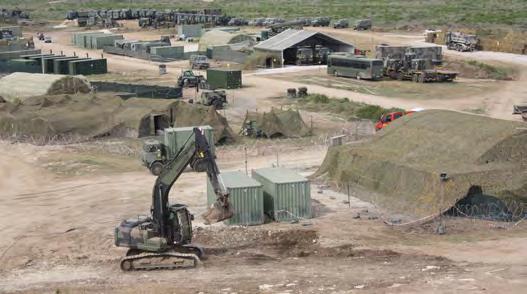
6As node, in the network theory, we would define this as the fundamental part of the system which possesses one or more interactions with other elements of the system (i.e. in the power grid system the power plants are nodes connected between them by the distribution grid).

7Vulnerability is a component of a system where security systems are compromised or non-existent (www.wikipedia.org) 8Risk is the possibility that an action or a choice (or the lack of it) will cause a loss or an unfavourable event (www.wikipedia.org)

volved in the CIP. This coordination works with the application of shared measures such as:
- Critical infrastructures identification;
- Standard CIP directives creation;
- Creation of Contingency Plans regarding the country’s prioritized threats list;
- Drafting of periodical “risk assessments” of critical infrastructures identified through the country’s intelligence agency’s threat list;
- Exchange of information between governmental agencies/organizations and the private companies who manage the identified critical infrastructures. Military Forces involvement in Critical Infrastructure Protection
As reported in the initial statement, increasing urbanization is creating a higher dependency upon the infrastructures which are responsible for essential services. The use of military force cannot be avoided in the strategic process, through the lens of a “Comprehensive Approach” and in a time of “Hybrid Warfare” which puts Critical Infrastructures as primary operational targets. The NATO supporting role to governmental authorities in CIP, which still remain a national responsibility, is one of the employment of military forces; related studies and concepts are being modelled by the Civil Emergency Planning Committee (CEPC) which is the primary NATO organization in the Civil Pro-
tection Planning Process. CEPC aims to protect the member country populations against all threats which could disrupt their well-being and development. In this role you can include “info sharing” and “intelligence” activities and lately also the sharing of military capabilities on “Cyber Warfare” with the creation of Centres of Excellence (NATO Cyber defence COE in Tallinn) and the drafting of doctrine and the execution of exercises. The availability of selected team of experts ensure the availability of a pool of SMEs which will allow support to the member countries in case of a crisis/event involving Critical Infrastructures. At a country level, when the threat level increases, military forces are employed in support of the police forces in the protection of critical and strategic infrastructures (i.e. Strade Sicure operation in Italy and VIGIPIRATE operation in France) in order to improve the security level.
In the case of critical infrastructure as a strategic objective the protection concept designed by the planner changes to a “pro-active” model in which the objective is not to act to minimize the impact of an incident but to physically block any threat to them. The CIP on operations tends to serve a double purpose, primarily to permit the operational development and to reach the operation objectives (i.e. sea port, airport, transit and staging areas, data transfer infrastructures)
8 …...It is important to emphasize that creating or repairing infrastructure per se’ is not the goal, except when that is essential in order to save lives. The ultimate goal is to assist the HN to set up the means for the provision of fundamental government services to a target population, with a view toward long-term sustainability of the project or sector involved. The importance of this approach and these projects cannot be overstated. (USA Joint Force Command – Handbook for Military Support to Essential Services and Critical Infrastructure - 2010)


and secondarily to support the population as stated in the comprehensive approach doctrine.
NRDC ITA experiences as a Joint Task Force HQ at operational level.
An operational level HQ like NRDC ITA employed as Joint Task Force, pending crisis management operations will confront CIP during all the operational phases:
During the planning process the CPOE (Comprehensive Preparation of the Operational Environment) critical infrastructure and the PMESII (Political, Military, Economic, Social, Informative and Infrastructures) domains all interact. Specialist Staff members (Engineer, Geo, Info), with the cooperation of external resources such as “Riserva selezionata” officers (economists, political and cultural advisors), will study the crisis area underlining all the possible implications of the infrasructures on the studied territory and its society. Synergy between civilian authorities and the military, in the initial phases, would be achieved through the employment of specialised teams (Operational Liaison Recce Teams – OLRTs), which upon deployment in a crisis zone will acquire all the information needed in order to identify the infrastructures which are of importance to the Host Nation and for the eventual conduct of military operations. During the preparation process to transform NRDC-ITA into a Joint Operational HQ the OLRT has been physically deployed to the JWC Joint Warfare Centre (JWC) in Stavanger (NOR) in order to interact with “role players” playing the roles of military and civilian authorities of a failing State who requested NATO intervention in support of local institutions. This has

been necessary in order to allow the planner of the Joint Operational Planning Group (JOPG) to choose the right force posture and the “courses of action” in order to fulfil the mission assigned by the Strategic plan. Interdependencies and characteristics of the designed infrastructure has to be linked to the planning process in order to maximize the available resources. Militaries can not replace civilian authorities in the management of critical infrastructure because it is not possible to rebuild the totally destroyed infrastructure of a country with military resources so the focus is toward their protection in order to avoid consequences which will be difficult to manage and would have a deep impact on the operational conduct. For example the help of specialists in chemical engineering and plant design in order to have qualified consulting on the protection of infrastructure such as Refineries or Oil fields.
During the Operational conduct phase the employed HQ staff will conduct continuous “assessments” and interaction with multi-disciplinary working groups (i.e. the Cyber Defence Working Group at a multinational and joint level and which is included in the NRDC-ITA “core process”), in order to employ those measures and adjustments needed to defend the critical infrastructure identified during the planning phase. Also important at the operational level is the designation of reach-back capabilities, the use of the highly specialized capabilities usually not present in the military but that can be found in the Research and Development Centres in the Country. The operational level measures employed by the NRDC ITA HQ are represented by the employment of highly specialised
assets with “dual-use” capabilities who are best designated to operate in synergy with civilian authorities. As stated before, military support is realized through the upgrade of passive defence measures and in support of the virtual space with anti-Cyber attack response units. In the first case Engineer units could intervene with works and engineering assets which could improve the passive defences of the designated critical infrastructure against attack with explosive devices or complex assault. The creation of Stand-off zones, and surveillance systems setup are jobs that any engineer unit could easily do as well as in precarious staging conditions. Other specialist support could be provided by CBRN units as prevention or response to an incident involving critical infrastructure. In addition to specialist support the employment of the Infantry is also important in order to assure the security bubble and the information collection which will be included in the intelligence process needed to avoid attacks against the critical infrastructure in the AOR. In the protection of the Virtual space the use of Signals units in support of the civilian authorities would ensure the rapid response capabilities and the flexibility typical of the militaries. NATO has already included into its planning measures to respond to incident and Cyber-attacks aimed to disrupt the information transmission systems needed to ensure Command and Control capabilities and critical
infrastructure functions. In a Joint operation you must not underestimate Naval and Air capabilities which are of high importance for their capacity to allow a rapid deployment of forces and their capacity to serve as forward Command and control centres (C2 Afloat) in operations near the areas to be protected.The CIP is a high priority for any country which is integrated in the global system. The protection strategy not only involves security with its usual actors (militaries, police and intelligence) but also a collection of integrated measures shared between civilian authorities and private sector, aimed to maximise the effort to counter both natural and man-made threats to the population’s well-being. The military has to take into account all the interactions which surrond critical infrastructure and include them in the planning and conduct process of every military operation. Specialization and a multi-dimensional approach towards CIP rends NRDC-ITA HQ a very valuable asset to National Civilian Authorities and the NARO itself which can count on a Rapid deployable and employable unit to tackle any crisis for the foreseeable future.

9 The new (NATO) policy also reflects Allied decisions on issues such as streamlined cyber defense governance, procedures for assistance to Allied countries, and the integration of cyber defense into operational planning (including civil emergency planning). Further, the policy defines ways to take awareness, education, training and exercise activities forward, and encourages further progress in various cooperation initiatives (http://www.nato.int/cps/en/natohq/topics_78170.htm)


During Exercise EAGLE READY, the Operational Liaison and Reconnaissance Team (OLRT) deployed to Poland to conduct meetings with Host Nation actors and a Command Post recce. Unlike previous exercises when the CIS (Communications Information System) provider for deployable support to our OLRT was the NCISG (NATO CIS Support Group), this time, the CIS Kits have been held and operated by the 1st Italian Signal Regiment. This was the first occasion when these newly established and accredited kits were deployed and tested under realistic exercise conditions, and the result was a qualified success. In preparation for the JTF Standby period, J6 and the 1st Signal Regiment had built up a range of CIS capabilities to support the OLRT and the Joint Logistic Reconnaissance Team (JLRT). These capabilities were formed from existing equipment, but tailored to the requirements of the Recce Teams. The Regiment now holds one “Heavy Kit” and four “Light Kits”. The Heavy Kit is designed to support the core of the OLRT with their higher information flow demands and their requirement to reach back to the Permanent Headquarters (PHQ). One heavy kit deployed to Poland, and provided the primary CIS link between the OLRT and the PHQ. The Light Kits are configured to support smaller recce teams that may be deta-

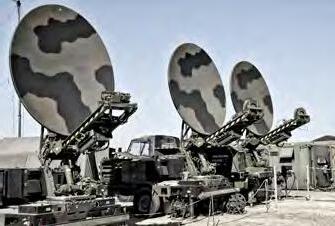
ched from the core of the OLRT or JLRT during a mission. All of these CIS Kits are accredited to provide connectivity to the NATO SECRET network, but in addition, they also provide internet access as well as secure and insecure voice services. The final CIS capability is offline encryption software that can protect files up to NATO RESTRICTED to be sent over the internet. This capability is suited to small staff teams operating with a low profile. This facility was used by the JLRT during the exercise to send recce reports back to the Combined Joint Operations Centre (CJOC), and can be operated by the staff without CIS technicians. For Exercise EAGLE READY, the Heavy and Light Kits were deployed to Poland by a commercial transport company in order to save the cost of air cargo. However, normally, they would be deployed with the OLRT/JLRT in military or commercial air transport. Both kits are packaged in transportable containers, and do not require mechanical handling equipment. The Heavy Kit includes a military satellite dish, which is the largest single component. In contrast, the Light Kit uses a commercial folding satellite antenna, and is much more agile and easily transportable.
While the Heavy Kit supported the OLRT Staff throughout the exercise, the Light Kit was run up and tested by J6 and the Regimental operators to identify and va-


lidate its capacity and capabilities. A total of 6 CIS Technicians deployed to set up and operate the two kits. A number of important lessons were identified from this CIS deployment. The Heavy Kit performed exceptionally well, and met the Information Exchange Requirements of the OLRT Staff and fully supported the information flows between the OLRT and the PHQ. It provided robust connectivity to NATO SECRET and the Internet, and supported: email, web browsing, NS VTCs, LYNC conferences and Polycom conferences. The results of the Light Kit testing confirmed that the bandwidth from the commercial satellite antenna does limit its functionality. If deployed,
it is recommended only to use simple voice services and NATO SECRET emailing without attachments.
As part of the ITA MoD project to upgrade NRDC-ITA’s CIS equipment, these OLRT Kits will be progressively replaced by smaller and more capable assets. The first new kit is expected to be delivered in early 2016.
In summary, Exercise EAGLE READY provided an excellent opportunity to test and validate the organic CIS Kits developed by J6 and 1st Signal Regiment to meet the JTF Standby requirement. Thanks to the technical competence, ingenuity and skills of the signallers, these kits performed well and fully supported the staff’s requirements.

MILAN, 20th March 2016
“Stramilano 16” Race
The most important sport event of the year for the NRDC-ITA running club



Lt. Col. ITA (A) Arnaldo IGNE, assigned to NRDC-ITA in July 2010, J4 Current Operations
The NRDC-ITA Running Club is one of the largest sport clubs in NRDC-ITA. We have around 70 members, both military and family members. The club founded in 2007 since then the club has participated in a large number of national and international events. The Club follows the wider aim of NRDC-ITA Sport Club by promoting cohesion and team building among the wider military community. Our members participate in events ranging in distance from 10 km to Marathon and Ultra Marathon in road race, trail race and Nordic Walking disciplines. Take a challenge!
As of this year, the NRDC-ITA Running Club has joined in the Italian Athletics Federation (FIDAL) and the Italian National Olympic Committee (CONI) as a Sport Association, in order to raise our profile and compete at the highest possible level. Every year begins with the Half Marathon of San Gaudenzio in January in Novara. This features running with the wind and snow in a breathtaking white panorama. Later in the year, we took part in the STRAMILANO, an annual athletics international event that takes place in Milan, in the spring. The NRDC-ITA Running Club with the wider NRDC-ITA community participated in the STRAMILANO

International Half Marathon (21.0975 km) with 40 runners and with 501 runners for the STRAMILANO (10km) and STRAMILANINA (5km). A few week later, we participated in MILANO Marathon with 3 runners and with 4 teams (16 runners for the Relay Marathon. All competed the race successfully. We were also represend in a successful Half Marathon in Como with 14 runners. We have some notable performances in our ranks.
OR2 Lollo Antonino completed the Vittuone (NO) Half Marathon in an excellent 1 hour and 11minutes and OR9 Vitulano Matteo covered 500km in 2015. Take a future challenge!
The next project for the NRDC-ITA Running Club will be to participate in competitions with other NATO Commands. This will be a Sport Exchanging Program for promoting friendships and building a cooperative system between NATO Commands
In summary, running in races is different from running alone! Let’s start all together and participate in the wide range of race with the NRDC-ITA Running Club. Our motto is that being the first or the last is not important when you run a race. If you run, you will be a winner, because you have the courage to run and to get in the game, while real losers are those who might run, but they don’t.
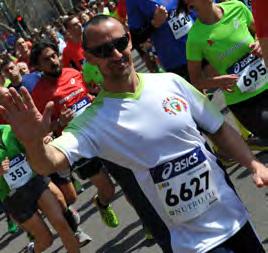


On Sunday 29 May 2016, the 2nd Handicapped Scuba Association (HSA) ”Experience Dive” course and the “Dive Buddy” course took place at the Ugo Mara barracks in Solbiate Olona (VA) and at the “Bustese Nuoto” swimming pool in Castellanza (VA). In close cooperation with the Italian HSA, the NATO Rapid Deployable Corps Italy (NRDC-ITA) Scuba Diving Club repeated the success achieved in 2015, pushing the project entitled: “A sea for everybody”. This project gives the opportunity to better under-
stand the difficulties faced by people with physical disabilities and to form relationships whilst undertaking scuba activities. This course will allow all Club members of any scuba diving skill level the chance to learn theoretical and practical techniques that will enable them to ease physically challenged people underwater and share with them the joy and emotions of this fantastic sport in a safe and controlled environment. At the end of the course, the HSA “Experience Dive” and “Dive Buddy” certificates were issued to all participants.
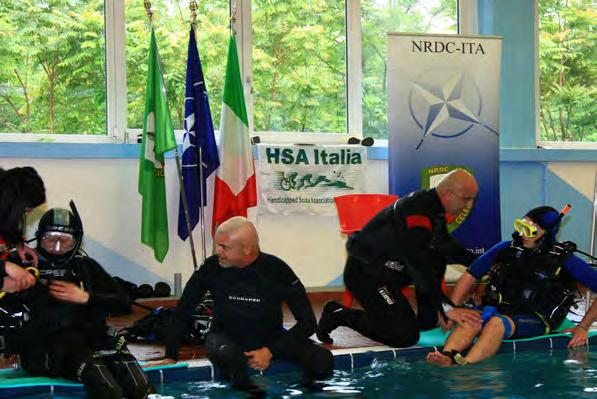
 Mrs Laura Deboli Marchiò, President NIWIC (NRDC-ITA Women’s International Club)
Mrs Laura Deboli Marchiò, President NIWIC (NRDC-ITA Women’s International Club)
Once more we were able to enjoy International Day, an occasion for all of us at NRDC-ITA to meet together with our families and friends, and spend a happy afternoon in good company.
International Day offers many enjoyable activities, such as music, shows, exhibitions of vehicles and equipment, food stalls and so much more. But there is more to it than that.
Like every year, NIWIC (the NRDC-ITA Women’s International Club) took this opportunity to carry out one of its main tasks: to collect funds for charities through the generosity of all the participants.
This year, from the many charity organisations active in Italy, an educational community for children called “La casa gialla,” based in Busto Arsizio, was chosen.
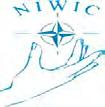

It is a non-profit organisation that plays a vital role in the future of so many children who have difficulties at home.
To this end, among the many stands set up for International Day, there was one organised and managed by the many volunteers from our Club, who, through the distribution of gadgets, sweets and cakes and collection of donations, demonstrated the aims and activities of NIWIC and its initiatives for charity.
The success of our work was rewarded by the smiles and sincere thanks of the charity, which, thanks to the big hearts of the people at NRDC-ITA, can now realise some of its plans for the children under its care.
For my part a big thank you to the friends of NIWIC for the support they have always given and the tenacity with which they face every new initiative of the Club.
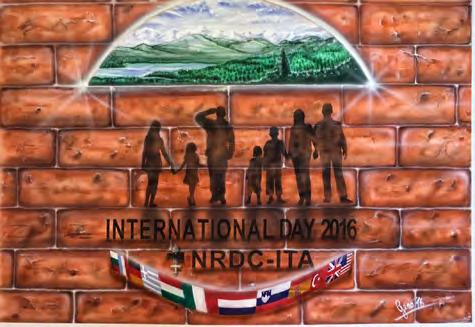


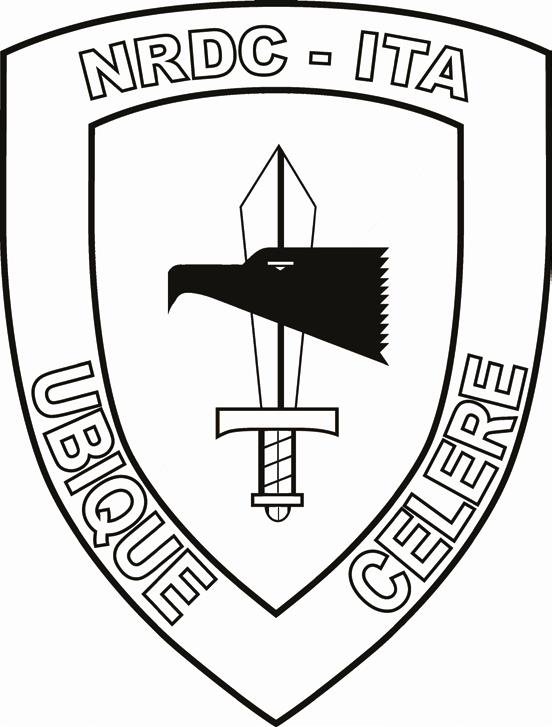
6th April - The “Ugo Mara” Barracks hosted the first high profile seminar on the influence pillar within NATO community. The aim of the conference was to enhance influence perspective in operations and to share experiences and lessons learned after the transformation and validation process as Joint Task Force Headquarters. Together with other activities of NRDC-ITA, these conferences are also a way to establish a link between the different Divisions within the HQs and the Academic world
1st May - NRDC-ITA hosted the 3rd annual Joint Logistic Support Group (JLSG) Conference chaired by SHAPE (Supreme Headquarters Allied Powers Europe). Together with selected NRDC-ITA staff, 45 officers from 19 NATO countries attended the two day Conference on NATO Logistics, actively participating to share situational awareness on JLSG developments and agreeing the comprehensive approach for the future. The NRDC-ITA selected representatives have shared their experiences on Logistics Command and Control architecture achieved following the Joint Task Force Headquarters validation process.
21st April - At the Italian Army Officers’ Applied Studies School in Turin, Lt. Gen. Riccardo Marchiò represented NRDC-ITA during the ceremony of inauguration of the monument dedicated to Maj. Giuseppe La Rosa, the last Italian Army Officer fallen on military operations, awarded with the Gold Medal For Military Bravery. Maj. La Rosa, whilst serving in the 3rd Bersaglieri Regiment deployed in ISAF mission in Afghanistan, was victim of a terrorist attack in Farah, on the 8th of June 2013. With a heroic act he put his body as a shield to protect his team from a hand grenade thrown inside their vehicle. Among others, the presence of Maj. La Rosa’s mother was particularly appreciated. The ceremony coincided with the closing ceremony of the 141st Italian Staff College Course, the one that should have been attended by Maj. La Rosa.



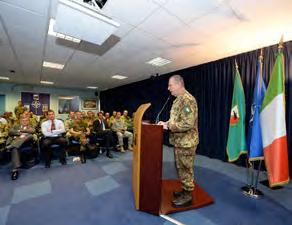
24th May - A new professional workshop has been started at “Ugo Mara” Barracks. The aim of these doctrinal event is to discuss all relevant challenges in today’s ever-changing environment, approaching them with the NATO concept of “comprehensive approach”.
During this specific events NRDC-ITA gained advantage from sharing discussions with Civilian professors as well as military experts. For this 2-day Workshop there were 25 in total, coming from 12 different headquarters, with their personal experience during each own validation process.
